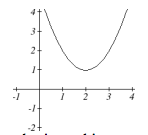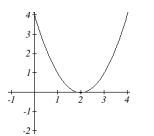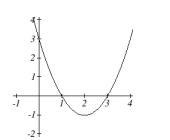Learning Objectives
- Quadratic Equations with Complex Solutions
- Use the quadratic formula to solve quadratic equations with complex solutions
- Connect complex solutions with the graph of a quadratic function that does not cross the x-axis.
- The Discriminant
- Define the discriminant and use it to classify solutions to quadratic equations
In this lesson we will bring the concepts of solving quadratic equations and complex numbers together to find solutions to quadratic equations that are imaginary. You will also learn about a really useful quality of the quadratic formula that can help you know whether a quadratic equation has real or complex solutions.
We have seen two outcomes for solutions to quadratic equations, either there was one or two real number solutions. We have also learned that it is possible to take the square root of a negative number by using imaginary numbers. Having this new knowledge allows us to explore one more possible outcome when we solve quadratic equations. Consider this equation:
[latex]2x^2+3x+6=0[/latex]
Using the Quadratic Formula to solve this equation, we first identify a, b, and c.
[latex]a = 2,b = 3,c = 6[/latex]
We can place a, b and c into the quadratic formula and simplify to get the following result:
[latex]x=-\frac{3}{4}+\frac{\sqrt{-39}}{4}, x=-\frac{3}{4}-\frac{\sqrt{-39}}{4}[/latex]
Up to this point, we would have said that [latex]\sqrt{-39}[/latex] is not defined for real numbers and determine that this equation has no solutions. But, now that we have defined the square root of a negative number, we can also define a solution to this equation as follows.
[latex]x=-\frac{3}{4}+i\frac{\sqrt{39}}{4}, x=-\frac{3}{4}-i\frac{\sqrt{39}}{4}[/latex]
In this section we will practice simplifying and writing solutions to quadratic equations that are complex. We will then present a technique for classifying whether the solution(s) to a quadratic equation will be complex, and how many solutions there will be.
In our first example we will work through the process of solving a quadratic equation with complex solutions. Take note that we be simplifying complex numbers – so if you need a review of how to rewrite the square root of a negative number as an imaginary number, now is a good time.
Example
Use the Quadratic Formula to solve the equation [latex]x^{2}+2x=-5[/latex].
We can check these solutions in the original equation. Be careful when you expand the squares, and replace [latex]i^{2}[/latex] with [latex]-1[/latex].
| [latex]\begin{array}{r}x=-1+2i\\x^{2}+2x=-5\\\left(-1+2i\right)^{2}+2\left(-1+2i\right)=-5\\1-4i+4i^{2}-2+4i=-5\\1-4i+4\left(-1\right)-2+4i=-5\\1-4-2=-5\\-5=-5\end{array}[/latex] | [latex]\begin{array}{r}x=-1-2i\\x^{2}+2x=-5\\\left(-1-2i\right)^{2}+2\left(-1-2i\right)=-5\\1+4i+4i^{2}-2-4i=-5\\1+4i+4\left(-1\right)-2-4i=-5\\1-4-2=-5\\-5=-5\end{array}[/latex] |
Example
Use the quadratic formula to solve [latex]{x}^{2}+x+2=0[/latex].
Now that we have had a little practice solving quadratic equations whose solutions are complex, we can explore a related feature of quadratic functions. Consider the following function: [latex]f(x)=x^2+2x+3[/latex]. Recall that the x-intercepts of a function are found by setting the function equal to zero:
[latex]x^2+2x+3=0[/latex]
The function now looks like the type of quadratic equations we have been solving. In the next example, we will solve this equation, then graph the original function and see that it has no x-intercepts.
Example
Find the x-intercepts of the quadratic function. [latex]f(x)=x^2+2x+3[/latex]
The following video gives another example of how to use the quadratic formula to find solutions to a quadratic equation that has complex solutions.
The Discriminant
The quadratic formula not only generates the solutions to a quadratic equation, it tells us about the nature of the solutions. When we consider the discriminant, or the expression under the radical, [latex]{b}^{2}-4ac[/latex], it tells us whether the solutions are real numbers or complex numbers, and how many solutions of each type to expect. The table below relates the value of the discriminant to the solutions of a quadratic equation.
| Value of Discriminant | Results |
|---|---|
| [latex]{b}^{2}-4ac=0[/latex] | One repeated rational solution |
| [latex]{b}^{2}-4ac>0[/latex], perfect square | Two rational solutions |
| [latex]{b}^{2}-4ac>0[/latex], not a perfect square | Two irrational solutions |
| [latex]{b}^{2}-4ac<0[/latex] | Two complex solutions |
A General Note: The Discriminant
For [latex]a{x}^{2}+bx+c=0[/latex], where [latex]a[/latex], [latex]b[/latex], and [latex]c[/latex] are real numbers, the discriminant is the expression under the radical in the quadratic formula: [latex]{b}^{2}-4ac[/latex]. It tells us whether the solutions are real numbers or complex numbers and how many solutions of each type to expect.
Example
Use the discriminant to find the nature of the solutions to the following quadratic equations:
- [latex]{x}^{2}+4x+4=0[/latex]
- [latex]8{x}^{2}+14x+3=0[/latex]
- [latex]3{x}^{2}-5x - 2=0[/latex]
- [latex]3{x}^{2}-10x+15=0[/latex]
We have seen that a quadratic equation may have two real solutions, one real solution, or two complex solutions.
In the Quadratic Formula, the expression underneath the radical symbol determines the number and type of solutions the formula will reveal. This expression, [latex]b^{2}-4ac[/latex], is called the discriminant of the equation [latex]ax^{2}+bx+c=0[/latex].
Let’s think about how the discriminant affects the evaluation of [latex]\sqrt{{{b}^{2}}-4ac}[/latex], and how it helps to determine the solution set.
- If [latex]b^{2}-4ac>0[/latex], then the number underneath the radical will be a positive value. You can always find the square root of a positive, so evaluating the Quadratic Formula will result in two real solutions (one by adding the positive square root, and one by subtracting it).
- If [latex]b^{2}-4ac=0[/latex], then you will be taking the square root of 0, which is 0. Since adding and subtracting 0 both give the same result, the “[latex]\pm[/late]" portion of the formula doesn't matter. There will be one real repeated solution.
- If [latex]b^{2}-4ac<0[/latex], then the number underneath the radical will be a negative value. Since you cannot find the square root of a negative number using real numbers, there are no real solutions. However, you can use imaginary numbers. You will then have two complex solutions, one by adding the imaginary square root and one by subtracting it.
Example
Use the discriminant to determine how many and what kind of solutions the quadratic equation [latex]x^{2}-4x+10=0[/latex] has.
In the last example, we will draw a correlation between the number and type of solutions to a quadratic equation and the graph of it's corresponding function.
Example
Use the following graphs of quadratic functions to determine how many and what type of solutions the corresponding quadratic equation [latex]f(x)=0[/latex] will have. Determine whether the discriminant will be greater than, less than, or equal to zero for each.
a.

b.

c.

We can summarize our results as follows:
| Discriminant | Number and Type of Solutions | Graph of Quadratic Function |
| [latex]b^{2}-4ac<0[/latex] | two complex solutions | will not cross the x-axis |
| [latex]b^{2}-4ac=0[/latex] | one real repeated solution | will touch x-axis once |
| [latex]b^{2}-4ac>0[/latex] | two real solutions | will cross x-axis twice |
In the following video we show more examples of how to use the discriminant to describe the type of solutions to a quadratic equation.
Summary
The discriminant of the Quadratic Formula is the quantity under the radical, [latex]{{b}^{2}}-4ac[/latex]. It determines the number and the type of solutions that a quadratic equation has. If the discriminant is positive, there are 2 real solutions. If it is 0, there is 1 real repeated solution. If the discriminant is negative, there are 2 complex solutions (but no real solutions).
The discriminant can also tell us about the behavior of the graph of a quadratic function.
Summary
Quadratic equations can have complex solutions. Quadratic functions whose graphs do not cross the x-axis will have complex solutions for [latex]f(x)=0[/latex].
Candela Citations
- Revision and Adaptation. Provided by: Lumen Learning. License: CC BY: Attribution
- Ex: Quadratic Formula - Complex Solutions. Authored by: James Sousa (Mathispower4u.com) . Located at: https://youtu.be/11EwTcRMPn8. License: CC BY: Attribution
- College Algebra. Authored by: Abramson, Jay et al.. Provided by: OpenStax. Located at: http://cnx.org/contents/9b08c294-057f-4201-9f48-5d6ad992740d@3.278:1/Preface. License: CC BY: Attribution
- Ex: The Discriminant. Authored by: James Sousa (Mathispower4u.com) . Located at: https://youtu.be/hSWs0VUyn1k. License: CC BY: Attribution
- College Algebra. Authored by: Abramson, Jay et al.. Provided by: OpenStax. Located at: http://cnx.org/contents/9b08c294-057f-4201-9f48-5d6ad992740d@3.278:1/Preface. License: CC BY: Attribution
